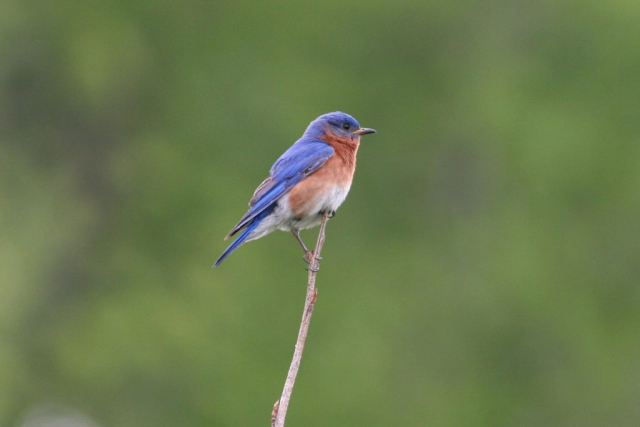Sialia sialis
Status: Common regular spring and fall migrant and breeder east and central, uncommon west. Uncommon regular winter visitor south, east, east central; rare casual west central and west.

Documentation: Specimen: UNSM ZM6688, 23 Mar 1891 Lincoln, Lancaster Co.
Taxonomy: Seven subspecies are recognized (AviList 2025), three north of Mexico: fulva of the southwest USA to central Mexico, bermudensis of Bermuda, and sialis, of southern and southeastern Canada, eastern and central USA and northeastern Mexico.
Nebraska birds are presumed sialis.
Hybridization of Eastern and Mountain Bluebirds is discussed at https://birds.outdoornebraska.gov/eastern-x-mountain-bluebird-hybrid/.
Spring: Mar 14, 16, 16 <<<>>> summer (west)
Earlier dates in the west are 3 Mar 2018 Lake McConaughy, Keith Co, 7 Mar 2015 singing male Wildcat Hills SRA, Scotts Bluff and Banner Cos, 10 Mar 2020 Scotts Bluff Co, and 12 Mar 2016 Wildcat Hills NC, Scotts Bluff Co.
Due to a decline in numbers as winter progresses, a spring influx is detectable in mid-Mar in the west; there are no Feb reports there and very few for early Mar. The 37 at Smith Lake WMA, Sheridan Co 16 Mar 2006 was a good count for the early date. In recent years spring migrants have become more numerous in the Panhandle.
Migrants become apparent in the east in late Feb and early Mar as overall numbers increase, peaking mid-Mar; because of wintering birds, early arrival dates are hard to discern. Five apparent migrants were in Brown Co 21 Feb 2020.
- High counts: 200 in Gage Co 11 Mar 2006, “hundreds” in southeast Lincoln Co 29 Mar 2006.
Summer: The historical range of oak savannah once defined the breeding range of Eastern Bluebird, which was generally limited to the southeastern third of Nebraska. Currently, however, this species breeds statewide, utilizing open areas where deciduous trees are present (Rosche 1982). Numbers are lowest in the western Sandhills and the southern Panhandle, and generally decline from east to west. The provision of nest boxes for bluebirds in the Panhandle and elsewhere has attracted Eastern Bluebirds in recent years. BBS trend analysis (Sauer et al 2020) shows Eastern Bluebirds have increased at an annual rate of 2.14% (95% C.I.; 0.71, 3.5) statewide during the period 1966-2019.
There are only about 17 reports from the western Sandhills for Jun-Jul (eBird.org, accessed Aug 2024), including seven reports at Crescent Lake NWR/WMA, Garden Co, five at or near Smith Lake WMA, Sheridan Co, singles in Grant Co along Abbott Road 18 Jun 2025, and at Hyannis, 28 Jun 2019, two for Arthur Co, 10 Jun 2020 and one along Highway 92 in Arthur Co 7 Jul 2017, and one about 11 miles north of Broadwater, Morrill Co 5 Jul 2020.
Expansion into the Pine Ridge is recent, but reports have increased markedly since 2000, and the species is now widespread as a breeder on the Pine Ridge (Mollhoff 2016). Although there are three old specimens for the Panhandle, two from Monroe and Warbonnet Canyons in northwest Sioux Co, 24 May 1900 (UNSM ZM6692 and ZM6693) and an immature from there 21 Jun 1901 (UNSM ZM6694), and Ducey (1988) cited a nest record card for Dawes Co in 1962, the first modern Pine Ridge record was as recent as 1974 in Sioux Co (Ducey 1988). Rosche (1982), however, had stated that there were no definite nesting records for the Pine Ridge at that time, and included only one summer report from the northwest, a pair at a hole in “cottonwood forest” at Box Butte Reservoir, Dawes Co in summer 1981. More recently, Wilson et al (1985, 1986, Williams 1985) found an apparent hybrid male Eastern X Mountain Bluebird mated with a female Mountain Bluebird in Dawes Co, some eight miles south of Crawford, in the summer of 1985. This pair fledged two broods from a nest box. Wilson et al (1986) suggested that hybridization in this case may have resulted from low numbers of summering Eastern Bluebirds in the area and the resulting shortage of mates. A nest with young was found in West Ash Canyon, Dawes Co, 2 Jun 2000 (Mollhoff 2001a), a male was feeding three recent fledglings in Smiley Canyon, Dawes Co, 1 Aug 2001, and a dependent fledgling was in Sioux Co 28 Jun 2024. A few miles south of the Pine Ridge, four young were fledged at Box Butte Reservoir, Dawes Co 8 Jul 1994 (Silcock and Rosche 1994).
The first nesting record in Scotts Bluff Co was in 1986, when a pair was present 24 May-2 Aug and used a box set out for Mountain Bluebirds (Cortelyou 1986). Most Eastern Bluebird sightings in Scotts Bluff Co are at the Wildcat Hills NC, where six pairs and at least one nestling were at the nest boxes there 13-14 Jun 1998, and seven nests were in nest boxes there 16 Jun 2002. Mollhoff (2016) did not show a notable increase in the number of reports from the Scotts Bluff Co area compared with Mollhoff (2001b), in contrast to the recent increases on the Pine Ridge.
The only records of breeding from the southern Panhandle are the fledging of four young in Cheyenne Co 4 Jul 2003, a nest with eggs in the Limber Pine BBA block, Kimball Co 25 Jul 2006 (Mollhoff 2016; unpublished data), confirmed breeding in Deuel County in 2007 (Mollhoff 2016), and an adult and juvenile at Oliver Reservoir, Kimball Co 19 Aug 2011.
- Breeding phenology:
Nest building: 7 Mar-30 May
Eggs: 31 Mar-15 Jul (Mollhoff 2022)
Nestlings: 14 Apr-17 Aug
Fledglings: 6 May- 30 Jul
In Otoe Co, 80 had fledged from boxes by 31 Jul 2005, and 90 by 31 Jul 2012. A productive nest-box near Bennington, Douglas Co produced three broods, each of three young, during summer 2010. First broods in Lancaster Co in 2019 had fledged by 24 Jun, with second brood eggs present.
Fall: Peak migration is in Oct; in the north and west most birds depart by late Oct, although there are numerous reports through Nov. Departure in the south and east is difficult to detect as many birds linger into winter.
Fall flocking may occur early; a flock of 19 was in Johnson Co 13 Jun 2012. Juvenile flocks may migrate independently of adults, remaining cohesive throughout winter and heading north as a flock the following spring (Gowaty and Plissner 2020).
- High counts: 300 in Lancaster Co 2 Nov 2010, 200-300 in Lincoln Co 20 Oct 2004, 200 between Center and Niobrara in Knox Co 3 Oct 1998, and “hundreds” in Lancaster Co 17 Sep 2011.
Winter: CBC data show that in Dec Eastern Bluebirds are still distributed statewide, but highest numbers are in the southeast. Observations from eBird (eBird.org, accessed Nov 2023) show that during Jan few remain in the north and west, and by Feb northward movement is beginning, most noticeably in the south-central and east.
Although there are about 40 midwinter (Jan) reports from the north, there are only five for the Panhandle, 1-7 Jan 2013 Lewellen, Garden Co, 20 Jan 1979 Scotts Bluff Co, 20 Jan 2021 Morrill Co, 28 Jan 2025 Scotts Bluff Co, and 31 Jan 2024 Lewellen, Garden Co.
High CBC counts include 286 at Branched Oak Lake-Seward, Lancaster and Seward Cos 16 Dec 2011, and 234 there 20 Dec 2015.
In 2020-2021, there was a severe decline in numbers, generally considered a result of intense and persistent winter cold in the Midwest that reduced the supply of food (Tim Barksdale); another observer (John Bissell) noted “Since Eastern Bluebirds are considered short distance migrants, I wonder if the harsh February weather in the southern US impacted Bluebird numbers”. There may have been other factors involved as well, as suggested by Joe Gubanyi: “The 49 tallied [on the Branched Oak-Seward CBC] in 2020 was the lowest tally since 2004. I did find several references that stated eastern bluebirds are vulnerable to harsh winters, but the CBC was done well before the extreme cold weather occurred, so something else may be affecting eastern bluebird numbers.” Nevertheless, there was much anecdotal data from bluebird nest box trails supporting lower numbers of nesting bluebirds, and a simple but controlled compilation of numbers of Eastern Bluebirds reported to eBird for the previous four years showed 477 in 2018, 464 in 2019, 624 in 2020, and 195 in 2021, a 69% decline 2020 to 2021 (Joel Jorgensen). This degree of decline was supported by reports of NOU members over the weekend of 15-16 May 2021 when Eastern Bluebirds were reported in 7 of 63 counties compared with 18 out of 60 in the 2020 event, a 63% decline. There was “much lower than normal” occupancy in a 50-box operation in Washington Co; only 5 boxes were occupied 12 Jun 2021. On the 6 Jan 2024 Lower Platte CBC, “Eastern Bluebird (19) bounced back a little bit from totals of 2, 14 and 1 recorded in the 3 most recent CBCs, but it has a long way to go for numbers to be comparable to average of 70 recorded during the first three years of the count [2010-2011 through 2012-2013]” (Joel Jorgensen).
Images
Abbreviations
BBA: Breeding Bird Atlas
BBS: Breeding Bird Survey
CBC: Christmas Bird Count
NC: Nature Center
NOU: Nebraska Ornithologists’ Union
NWR: National Wildlife Refuge
SHP: State Historical Park
SP: State Park
SRA: State Recreation Area
UNSM: University of Nebraska State Museum
WMA: Wildlife Management Area (State)
Acknowledgement
Photograph (top) of a Eastern Bluebird at Schramm State Park, Sarpy Co 7 May 2006 by Phil Swanson.
Literature Cited
AviList Core Team, 2025. AviList: The Global Avian Checklist, v2025. https://doi.org/10.2173/avilist.v2025.
Cortelyou, R.G. 1986. 1986 (Sixty-first) Spring Occurrence Report. NBR 54: 46-64.
Ducey, J.E. 1988. Nebraska birds, breeding status and distribution. Simmons-Boardman Books, Omaha, Nebraska, USA.
Gowaty, P.A. and J.H. Plissner. 2020. Eastern Bluebird (Sialia sialis), version 1.0. In Birds of the World (A. F. Poole, Editor). Cornell Lab of Ornithology, Ithaca, NY, USA. https://doi.org/10.2173/bow.easblu.01.
Mollhoff, W.J. 2001a. 1999-2000 Nebraska nesting report. NBR 69: 92-101.
Mollhoff, W.J. 2001b. The Nebraska Breeding Bird Atlas 1984-1989. Nebraska Ornithologists’ Union Occasional Papers No. 7. Nebraska Game and Parks Commission, Lincoln, Nebraska, USA.
Mollhoff, W.J. 2016. The Second Nebraska Breeding Bird Atlas. Bull. Univ. Nebraska State Museum Vol 29. University of Nebraska State Museum, Lincoln, Nebraska, USA.
Mollhoff, W.J. 2022. Nest records of Nebraska birds. Nebraska Ornithologists’ Union Occasional Paper Number 9.
Rosche, R.C. 1982. Birds of northwestern Nebraska and southwestern South Dakota, an annotated checklist. Cottonwood Press, Crawford, Nebraska, USA.
Sauer, J.R., W.A. Link and J.E. Hines. 2020. The North American Breeding Bird Sruvey – Analysis Results 1966-2019. U.S. Geological Survey data release, https://doi.org/10.5066/P96A7675, accessed 27 Jul 2023.
Silcock, W.R., and R.C. Rosche. 1994. Summer Field Report, June-July 1994, NBR 62: 102-116.
Williams, F. 1985. Southern Great Plains Region. American Birds 39: 931-933.
Wilson, B.L., J. Minyard, H. Minyard, and T.E. Bray. 1985. Hybrid bluebirds in the Pine Ridge. NBR 53: 67.
Wilson, B.L., J. Minyard, and H. Minyard. 1986. Hybrid bluebird update. NBR 54: 26-27.
Recommended Citation
Silcock, W.R., and J.G. Jorgensen. 2025. Eastern Bluebird (Sialia sialis). In Birds of Nebraska — Online. www.BirdsofNebraska.org
Birds of Nebraska – Online
Updated 28 Aug 2025

